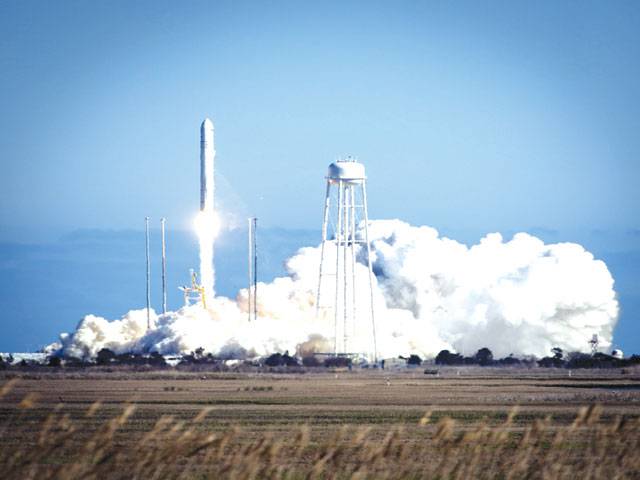WASHINGTON
BBC
A new rocket has launched from theUSeastern seaboard to prove its readiness to help service the International Space Station (ISS).
The 40m-tall Antares vehicle lifted clear of the Wallops Flight Facility inVirginiaat 1700 local time (2100 GMT). The apparently flawless 10-minute ascent should lead to it being allowed to propel an unmanned cargo ship towards the ISS later this year.
Antares has been developed by the Orbital Sciences Corporation (OSC). The Dulles-based company is one of a number of commercial outfits that have partnered with theUSspace agency (Nasa) to create cheaper technologies for getting payloads and astronauts into orbit.
The agency has so far invested some $275m (£180m) in OSC to help it advance its rocket and cargo-vessel concepts. A contract worth $1.9bn (£1.2bn), covering eight re-supply missions to the station, will be triggered once the company has satisfactorily demonstrated its designs.
Sunday’s test-flight required the two-stage Antares rocket raise itself to an altitude of about 255km where it jettisoned a dummy payload. That 3.8-tonne test mass was intended to simulate the Cygnus cargo ship, which will make its maiden outing on the next launch of the rocket.
Orbital is an established Nasa contractor, which has been building satellites and smaller rockets for more than 30 years. The company was chosen by the agency to pick up some of the ISS servicing capability lost byAmericawhen it retired its space shuttles two years ago.
A second firm, SpaceX of California, is further along in its development schedule, having already completed its test flights and begun commercially contracted missions to the ISS. OSC packed Sunday’s Antares full of sensors to gather as much data as possible on its performance.
Everything on the flight appeared to proceed extremely smoothly. All the major events such as rocket-stage separation, fairing separation, and the ejection of the dummy payload occurred on cue.
“We will obviously go in and analyse it much more carefully in the coming days and replay everything to make sure we get maximum information from the data. But at first glance, it all looked really good,” observed Frank Culbertson, an Orbital executive vice-president and a former astronaut.
Nasa too will want to review the flight data before deciding whether to release more seed funding to Orbital, and to clear the company for a Cygnus freighter demonstration mission to the ISS. All being well, this next demonstration could occur in late June or early July.
The early message from the agency was that it was very happy with Sunday’s outcome. “It was an amazing achievement for Orbital today,” said Alan Lindenmoyer, the manager of Nasa’s Commercial Crew and Cargo Program. “The flight was just beautiful. It looks like - the preliminary data says - that all the objectives we established for the flight were 100% met.”






